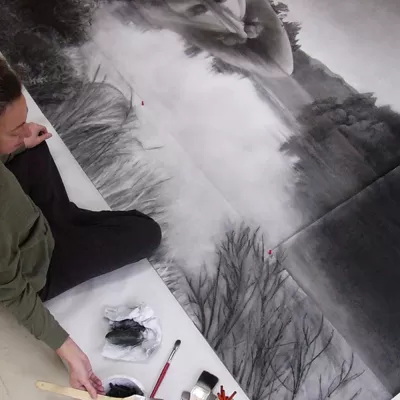The Limited Palette: A Good Place to Start
Required Supplies
BRUSHES
The ones marked * are must-haves for this class.
A variety of brushes, some or all of the following:
• bristle rounds sizes 2*, 4*
• bristle filberts and/or bristle flats sizes 4, 6*, 8
• soft sable or synthetic sable rounds sizes 0, 1, 2
• soft synthetic sable filberts sizes 6, 8,10
• economy White Bristle Brush size 2-inch* (these are sold as inexpensive gesso brushes at Blick)
SOLVENT
solvent both for cleaning brushes and for mixing painting mediums (see below)
• odorless mineral spirits, such as Gamblin “Gamsol”
SOAP
• plain white bar soap such as Ivory
OIL
linseed oil (refined)
PALETTE
• paper or wood or plexiglass
PALETTE/PAINTING KNIFE
These come in many shapes. For this class the best shape available at Blick:
• “Painting Knife - Small Long Spade 50”
PAPER TOWELS
We use these as a painting tool as well as for cleaning up. Bounty brand paper towels are best.
OIL PAINTS
Prismatic colors
• quinacridone red
• cadmium yellow medium
• ultramarine blue (note: not a phthalocyanine blue)
Earth colors
• earth red (PR 102): the best choices are Old Holland red ochre or Williamsburg “Italian Rosso Veneto” (note: notIndian red and not Venetian red because those colors are too strong)
• yellow ochre (PY 43): Old Holland yellow ochre light is best
• ivory black
White
• titanium white or titanium zinc white
PAINTING MEDIUMS
In a small glass jar, mix odorless mineral spirits and refined linseed oil for each day as follows:
• Day one—2 parts odorless mineral spirits plus 1 part refined linseed oil
• Day two—refined linseed oil
• Day three—2 parts odorless mineral spirits plus 1 part refined linseed oil
• Day four—1 part odorless mineral spirits plus 1 part refined linseed oil
• Day five—refined linseed oil
WHAT TO PAINT ON?
Not smaller than 9 x 12 inches. Here are a few options:
• stretched and primed canvas
• primed panel
• Arches “Huile” oil paper pad (an excellent product)
• Fredrix canvas pad (these are not sold at Blick in Seattle, but they can be ordered online. This brand is far superior to Blick canvas pads)
• gessoed mat board or museum board—Use a minimum of 3 coats of Golden white acrylic gesso. Change the direction of the brushstrokes for each layer.
Note: Avoid “canvas panels” which are inferior grade primed canvas wrapped around cardboard.
ON THE FIRST DAY OF CLASS…
From the above list, the only these supplies are needed:
• brushes—bristle rounds sizes 2, 4
• a jar of odorless mineral spirits for cleaning brushes
• a bar of soap
• a small jar of medium—2 parts odorless mineral spirits plus 1 part refined linseed oil
• palette
• palette/painting knife
• paper towels
• oil paints—ultramarine blue and titanium or titanium zinc white
• a surface upon which to paint
We will go over the complete list of materials on the first day of class, and I will display a variety of brushes. I will also demonstrate how to clean up, for those who are new to oil painting.








